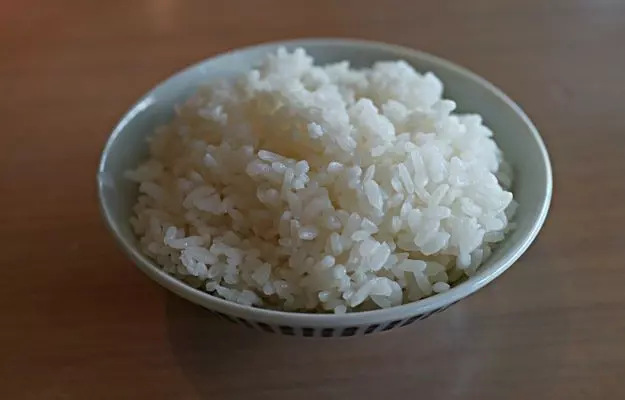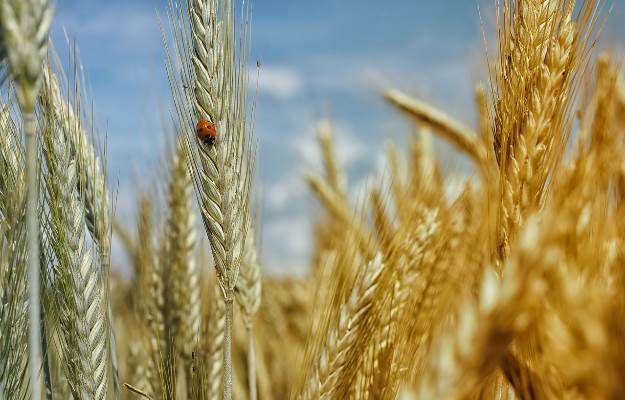One of the most commonly used grains in India, rice comes in many varieties and forms. White rice is a key variety of rice that is a staple in many countries, especially Asian countries like India, Bangladesh, China, Thailand, Vietnam and Japan. In India, white rice is consumed daily in many states. Varieties of white rice like basmati, gobindobhog, dubraj and indrayani. These varieties may be long-grain, short-grain, scented or polished depending on their production process.
It is very important to note that both white rice and brown rice come from the same plant. The only difference between these two - and it is a big difference when it comes to nutrition - is that brown rice refers to the entire grain of rice with the layers of bran, germ and endosperm. White rice, on the other hand, refers to the grains from which the bran and germ have been removed and only the endosperm remains. This makes white rice less rich in dietary fiber and essential minerals compared to brown rice.
(Read more: Fiber-rich foods)
Did you know?
While the world may be shifting in favour of brown rice, the ancient Indian medicinal practice of Ayurveda embraces the benefits of white rice. This is because white rice, especially long-grain, naturally fragrant white rice varieties like basmati, is considered to be light and easy to digest. Ayurvedic texts also suggest that eating white rice can help balance the three doshas of vata, pitta and dosha.
Some basic facts about white rice:
- Botanical name: Oryza sativa
- Family: Poaceae
- Common name: Rice, chawal
- Sanskrit name: Vrihi, tandul, shali
- Parts used: Whole grain
- Native region and geographical distribution: Varieties of white rice are grown all over Asia. China is the leading producer of rice, followed by India, Indonesia and Bangladesh.
(Read more: White rice or brown rice, which is healthier?)
- White rice nutrition facts
- White rice health benefits
- White rice improves digestion
- White rice is gluten-free
- White rice provides quick energy
- White rice side effects
- White rice may lead to weight gain
- White rice increases diabetes risk
- White rice can cause metabolic syndrome
- White rice may lead to arsenic poisoning
- Takeaways
White rice nutrition facts
The nutritional content of white rice remains more or less the same whether it is long-grain rice or short-grain rice. The nutritional content of some brands of white rice, however, may be different in case they have been fortified with certain vitamins and minerals. According to the US Department of Agriculture, the following are the nutritional facts for long-grain and cooked white rice.
| Nutrient | Value per 100g |
| Water | 68.44 g |
| Energy | 130 kcal |
| Protein | 2.69 g |
| Total lipid (fat) | 0.28 g |
| Carbohydrate | 28.17 g |
| Minerals | |
| Calcium | 10 mg |
| Iron | 1.2 mg |
| Magnesium | 12 mg |
| Phosphorus | 43 mg |
| Potassium | 35 mg |
| Sodium | 1 mg |
| Selenium | 7.5 µg |
| Fluoride | 41.1 µg |
| Vitamins | |
| Niacin (B3) | 1.476 µg |
| Folate | 58 µg |
White rice health benefits
White rice is packed with carbohydrates and minerals. Even though it is low on vitamins and plant-proteins, rice is considered to be nutritious and beneficial for health by many. There are quite a few benefits you can get by including white rice in your diet. The following are a few of them.
(Read more: Healthy recipes)
White rice improves digestion
White rice is light and easy to digest. This is partially because white rice does not contain the high-fiber layers of bran and germ. The husk of the rice grain is completely removed from white rice and unlike brown rice, it does not contain phytic acid. This ensures that eating cooked white rice does not irritate the stomach or intestines in any way. This is also the reason why when you have a stomach infection or diarrhoea, eating porridge, khichdi or curd rice made with white rice is recommended. People with conditions such as irritable bowel syndrome and inflammatory bowel disease also find white rice easier to digest.
White rice is gluten-free
A lot of people have a gluten intolerance, which makes it difficult for them to eat grains like wheat, barley and rye. Gluten is a complex protein and its malabsorption can occur in people with celiac disease and wheat allergy. This type of allergy can not only cause an allergic reaction but may also lead to an anaphylactic shock if not controlled in time. Rice does not contain any gluten, which is why it is safe for people with these gluten-related conditions to consume.
(Read more: Gluten-free foods)
White rice provides quick energy
For people suffering from low blood sugar levels or physically active people who burn too many calories, white rice is a great source of instant energy. Since white rice is easily digestible, it is processed quickly by the body to produce sufficient amounts of blood glucose and energy. This is also the reason why many sportspersons include white rice in their diet, and so do those who engage in manual labour professionally.
(Read more: What are calories?)
White rice side effects
While white rice has a few benefits to impart, many believe that the side effects of eating white rice far outweigh these benefits. This is also because white rice consumption has been associated with many chronic diseases over the years. The following are some such side effects linked to the consumption of white rice.
White rice may lead to weight gain
Many studies suggest that excessive consumption of any type of refined grain or flour can cause weight gain and obesity. This is because white rice is not nutrient-dense and stripped of dietary fiber. Additionally, rice is filling and those who eat more of it are usually found to be eating fewer fruits, vegetables, whole grains, nuts and seeds. This reduces their nutrient intake and causes their weight to shoot up. However, many studies also show that in countries where white rice is traditionally eaten, it can be an essential part of weight-loss diets as long as the portion size is controlled.
White rice increases diabetes risk
Foods that have a high glycemic index (GI) lead to higher blood glucose spikes, especially an hour after a meal. People with diabetes or prediabetes are recommended to consume low GI foods because not doing so can lead to unmanageable post-meal blood glucose rise. This can cause more harm to their system and lead to complications, some of which even regular medication intake cannot remedy. White rice has a GI of 64, which is considered to be quite high. People who have diabetes are recommended not to eat white rice. Moreover, some studies even suggest that eating excessive amounts of white rice can increase one’s risk of diabetes.
(Read more: What to eat and what not to eat in diabetes)
White rice can cause metabolic syndrome
Metabolic syndrome is not one disease but a cluster of conditions that can increase your risks of heart disease, stroke and type 2 diabetes. High blood pressure, high fasting blood sugar, a large waistline, high cholesterol and triglycerides are some of the risk factors that lead to metabolic syndrome. Excessive consumption of white rice is said to increase all of these risk factors and, therefore, eating it can cause metabolic syndrome.
White rice may lead to arsenic poisoning
Rice cultivation across the world is linked to high levels of arsenic poisoning. Arsenic poisoning occurs in parts of the world where this toxic element seeps into the water and soil, predominantly from fertilizers. Crops grown using these resources tend to be contaminated with arsenic and excessive consumption of the same can lead to long-term health issues like cancer and heart disease. Although brown rice contains higher amounts of arsenic than white rice, excessive and improper consumption of white rice can cause arsenic poisoning as well.
Takeaways
White rice is a type of refined or polished whole grain from which the bran and germ are removed. This gives white rice a very bad reputation, especially among the health-conscious. However, many believe that white rice is excessively and unnecessarily criticised for being unhealthy. This is because white rice consumption does have its own benefits too, including for those with IBS, IBD, celiac disease and wheat allergy. It is also one of the best things to eat when you have an upset stomach.
So, when it comes to white rice consumption, it is important to remember the proportion above everything else. If your portion of white rice is smaller than the portions of vegetables and meat then your meal is less likely to do you harm. However, it is best to ensure that the other dishes on your plate are simply cooked and healthy instead of being oily, spicy and too heavy.
This apart, it’s important that you wash white rice thoroughly before cooking. This can help get rid of some of the arsenic. Boiling the rice in excess water and draining the water away after the rice is cooked is another method of reducing the risk of arsenic poisoning. As long as you keep these things in mind and add other sources of nutrition to your diet, you should be able to enjoy white rice without any significant side effects. If your doctor has recommended that you completely cut off white rice, then it is best to follow this advice.
Find Nutritionist in cities
Doctors for White rice: Nutrition facts, benefits and side effects

Dr. Dhanamjaya D
Nutritionist
16 Years of Experience

Dt. Surbhi Upadhyay
Nutritionist
3 Years of Experience

Dt. Manjari Purwar
Nutritionist
11 Years of Experience

Dt. Akanksha Mishra
Nutritionist
8 Years of Experience
Medicines / Products that contain Rice
- Threptin Lite High Protein Supplement Diskette - ₹460
- Bluhenn Essentials Age Defying Serum 15 ml - ₹800
- Keeros Lightly Salted Multigrain, Healthy & Diabetic Friendly Roasted Super Snack 400gm - ₹300
- Bluhenn Essentials Facial Cleanser 75 gm - ₹450
- Kanan Naturale Husk Ash - Herbal Tooth Powder - ₹270
- Hawaiian Herbal Blue Berry Capsule-Get 1 Same Drops Free - ₹469
- Rooted Active Natural Plant Protein Plus Super Food 500gm - ₹799
- Keeros Lightly Salted Multigrain, Healthy & Diabetic Friendly Roasted Super Snack (Pack of 4)400gm - ₹1020
- Keeros Lightly Salted Multigrain, Healthy & Diabetic Friendly Roasted Super Snack (Pack of 2)400g - ₹560
- Himalaya Althea Cream - ₹90
- Patanjali Divya Vrikkdoshhar Vati - ₹42
- Kairali Kachoradi Choornam - ₹57
- HealthyHey Nutrition Organic Pea & Rice Protein Powder - ₹1599
- The Moms Co Natural Vita Rich Face Serum - ₹699
- The Moms Co Natural Soothing Relief Lotion - ₹599
- Swisse Skincare Bamboo Skin Refining Exfoliator - ₹799
- Aakaar Balback Hair Serum - ₹981
- Emami Healthy & Tasty Refined Rice Bran Oil - ₹90
- Himalaya Althea Lotion - ₹133
- Kapiva Raw Meal Replacement Mango - ₹1399
- Kairali Pinda Thailam - ₹209
- Kairali Maharajaprasarani Thailam - ₹90
- Samisha Organic Coconut Milk & Rice Flour Skin Healing Bathing Bar 100gm - ₹199
References
- FoodData Central. [Internet]. United States Department of Agriculture. Washington D.C. USA; Rice, white, long-grain, regular, enriched, cooked
- Krittanawong, Chayakrit. et al. Is white rice consumption a risk for metabolic and cardiovascular outcomes? A systematic review and meta-analysis. Heart Asia. 2017; 9(2): e010909. PMID: 29467837
- Fukagawa, Naomi K. and Ziska, Lewis H. Rice: Importance for Global Nutrition. J Nutr Sci Vitaminol (Tokyo) . 2019;65(Supplement):S2-S3. PMID: 31619630
- Mano, Fumika. et al. The Effect of White Rice and White Bread as Staple Foods on Gut Microbiota and Host Metabolism. Nutrients. 2018 Sep; 10(9): 1323. PMID: 30231542
- Kolahdouzan, Majid. et al. The association between dietary intake of white rice and central obesity in obese adults. ARYA Atheroscler. 2013 Mar; 9(2): 140–144. PMID: 23690814
- Dong, Fei. et al. White rice intake varies in its association with metabolic markers of diabetes and dyslipidemia across region among Chinese Adults. Ann Nutr Metab. 2015; 66(4): 209–218. PMID: 26068010
- Golozar, Asieh. et al. White rice intake and incidence of type-2 diabetes: analysis of two prospective cohort studies from Iran. BMC Public Health. 2017; 17: 133. PMID: 28137245
- Mattier, Josiemer. et al. A higher ratio of beans to white rice is associated with lower cardiometabolic risk factors in Costa Rican adults. Am J Clin Nutr . 2011 Sep;94(3):869-76. PMID: 21813808














